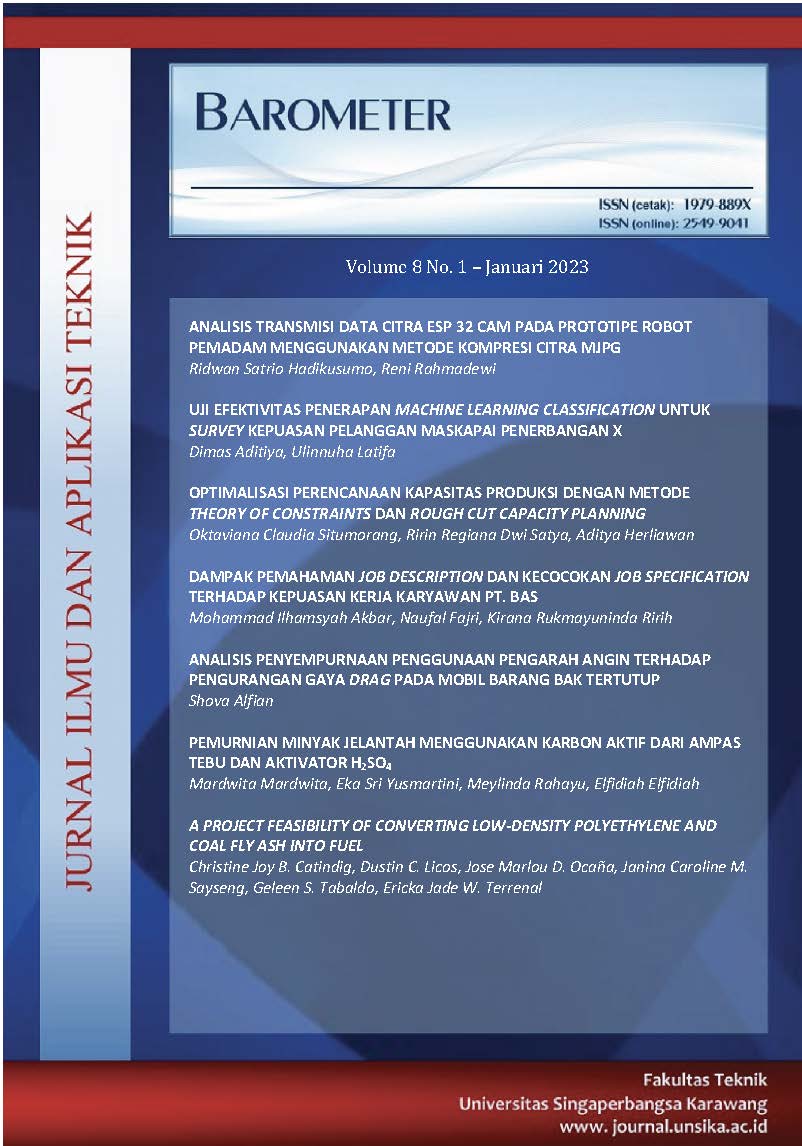A PROJECT FEASIBILITY OF CONVERTING LOW-DENSITY POLYETHYLENE AND COAL FLY ASH INTO FUEL
DOI:
https://doi.org/10.35261/barometer.v8i1.6917Abstrak
Ineptly handled plastic waste has both economic and environmental repercussions. The country's reliance on single-use plastics such as multilayer sachets and pouches has led to the country becoming a "sachet economy," worsening the region's concerning levels of land and marine plastic pollution. By most estimates, the Philippines use a massive 163 million sachets every day. Unfortunately, only the sachets have been counted, not the whole projected number of used plastics throughout the country. Thus, the researchers have proposed an idea to test the feasibility of converting low-density polyethylene and coal fly ash as catalyst into fuel. Coal fly ash is a byproduct that can be found most especially in coal-fired power plants. The plastics will undergo the process of pyrolysis wherein depolymerization takes place in order to produce fuel. For the Statistical Computation of the Sample Size to be Surveyed, the researchers used the Slovin’s formula wherein the obtained data and decided to use a 95% confidence level and 5% margin of error and therefore got 399 respondents. Forecasted demand was obtained using the Statistical Straight-Line Method with an average annual increase of 5.58%. The same method was used to forecast the supply which has an average annual increase of 4.49% for the next five years. The initial projected net sale is P515, 650,864.11. The highest possible quality of the desired product is attainable with 82.55% plant capacity utilization that operates in 287 possible manufacturing days with one production shift. The product underwent four different tests, all of which has a positive outcome for the product as an alternative for LPG. The total project cost is P400, 000,000.00 and has a 3.25 years payback period. Therefore, this project is feasible.
Unduhan
Referensi
“Market Study for Philippines: Plastics Circularity Opportunities and Barriers.,” World Bank Group, 15-Apr-2021. [Online]. Available: https://www.worldbank.org/en/country/philippines/publication/market-study-for-philippines-plastics-circularity- opportunities-and barriers-report-landing-page.
L. K. Subido, “Filipinos throw out over 163 million sachets and 93 million plastic bags each day,” Esquiremag.ph, 8-Mar-2019. [Online]. Available: https://www.esquiremag.ph/life/health-and-fitness/philippines-plastic-pollution-statistics-a00288-20190308.
F. Inegbedion, L. C. Igbonazobi, A. O. Imasuen, and C. O. Inetianbor, “Characterization of low density polyethylene waste filled with palm kernel shell,” International Journal of Engineering Technologies and Management Research, vol. 8, no. 4, pp. 71–78, 2021.
R. B. Finkelman, S. Dai, and D. French, “The importance of minerals in coal as the hosts of Chemical Elements: A Review,” International Journal of Coal Geology, vol. 212, p. 103251, 2019.
S. Mostafa Hosseini Asl, A. Ghadi, M. Sharifzadeh Baei, H. Javadian, M. Maghsudi, and H. Kazemian, “Porous catalysts fabricated from coal fly ash as cost-effective alternatives for industrial applications: A Review,” Fuel, vol. 217, pp. 320–342, 2018.
I. S. Goldstein, “Integrated plants for chemicals from biomass,” Organic Chemicals from Biomass, pp. 281–285, 2018.
I. Dubdub and M. Al-Yaari, “Pyrolysis of low density polyethylene: Kinetic study using TGA data and Ann Prediction,” Polymers, vol. 12, no. 4, p. 891, 2020.
“OIL INDUSTRY MANAGEMENT BUREAU’S (OIMB’S) YEAR-END COMPREHENSIVE REPORT (FY2019),” Department of Energy, 2020. [Online]. Available: https://www.doe.gov.ph/sites/default/files/pdf/downstream_oil/year-end-comprehensive-report-fy2021_update-06032022.pdf.
“OIL INDUSTRY MANAGEMENT BUREAU (OIMB) YEAR-END COMPREHENSIVE REPORT FY2020 ,” Department of Energy. , 2021. [Online]. Available: https://www.doe.gov.ph/sites/default/files/pdf/downstream_oil/year-end-comprehensive-report-fy2020.pdf.
A. A. Supriyanto, "THE EFFECT OF POWER GENERATION ON THE SURFACE TEMPERATURE OF THE FUEL AND REACTOR CORE FLUID", Barometer, vol. 2, no. 1, pp. 19–24, Jan. 2017.








